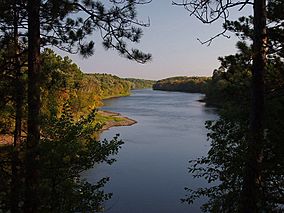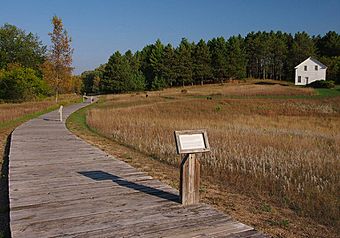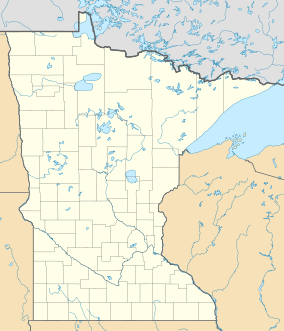Crow Wing State Park facts for kids
Quick facts for kids Crow Wing State Park |
|
|---|---|

The Mississippi River from Chippewa Lookout in Crow Wing State Park
|
|
| Location | Minnesota, United States |
| Area | 3,119 acres (12.62 km2) |
| Elevation | 1,158 ft (353 m) |
| Established | 1959 |
| Governing body | Minnesota Department of Natural Resources |
|
Crow Wing State Park
|
|

Townsite of Old Crow Wing, with the Clement Beaulieu House in the distance
|
|
| Location | Fort Ripley Township, Crow Wing County, Minnesota |
|---|---|
| NRHP reference No. | 70000288 |
| Added to NRHP | July 28, 1970 |
Crow Wing State Park is a cool place in Minnesota, United States. It's where the famous Mississippi River meets the Crow Wing River. This park helps us learn about a historic town called Old Crow Wing. This town was once one of the busiest places in Minnesota back in the 1850s and 1860s! The whole park was added to the National Register of Historic Places in 1970 because it's so important. A part of the old Red River Trails also runs through the park.
Contents
Nature and Wildlife at Crow Wing Park
Crow Wing State Park sits on land formed by ancient glaciers. These glaciers left behind a flat area called an outwash plain.
What Plants Grow Here?
Today, you'll find lots of oak trees in the park. There are also different kinds of pine trees, like red, white, and jack pines. You might also see aspen trees. Some parts of the park are open prairie or wetland areas.
Animals You Might See
The park is home to many animals. Keep an eye out for coyotes and white-tailed deer. You might spot an eagle flying high or a hawk. Down by the water, you could see a beaver, muskrat, or different kinds of waterfowl. Foxes and many types of songbirds also live here.
History of Crow Wing State Park
The spot where the Crow Wing and Mississippi Rivers meet was always a special place. It was easy to travel by river and there was good hunting. This made it a natural meeting point for people.
Native American History
Long ago, the Dakota people lived in this area. They sometimes had conflicts with the Ojibwe people, who were moving in from the east. A famous story from 1768 tells about a battle. Dakota warriors took some Ojibwe women in their canoes. When the Ojibwe warriors returned, they set up a surprise attack. They hid on a high bank and fired their rifles as the Dakota passed below. The captured women bravely overturned their canoes and swam to shore. The Dakota fought back on land, but the Ojibwe won. This two-day battle helped the Ojibwe gain control of the area.
The Old Crow Wing Town
In the late 1700s, European fur traders started visiting this area. A trading post opened in 1823, and a town slowly grew around it. The town was on a new part of the Red River Trails that opened in 1844. This made the town's economy grow very fast. Some traders from Crow Wing became very important in early Minnesota. In fact, three counties are named after them: Morrison, Aitkin, and Rice counties.
A Métis man named Clement Hudon Beaulieu ran the American Fur Company's trading post. Another Métis man, William Whipple Warren, wrote an early history of the Ojibwe people. Three churches were built in the town, including a Catholic mission started by Father Francis Xavier Pierz.
But Crow Wing's busy times ended quickly. In 1868, the Ojibwe people moved to the White Earth Indian Reservation. Then, in 1871, a railroad builder named James J. Hill decided to build his Northern Pacific Railroad bridge over the Mississippi River in Brainerd. Brainerd was about 10 miles (16 km) north of Crow Wing. By 1880, most people had left Crow Wing.
How the Park Was Created
The Crow Wing County Historical Society worked hard to make the townsite a state park. The Minnesota Legislature officially approved the park in 1959. There was a small debate when the Knights of Columbus built a chapel where Father Pierz's mission used to be. But the chapel was on private land, and no public money was used. So, it followed the rules about church and state.
In 2006, the park grew by 552 acres (223 ha) thanks to state money and private gifts. This added 3.13 miles (5.04 km) of land along the Mississippi River. There are plans to extend the Paul Bunyan State Trail through this new part of Crow Wing State Park.
Fun Things to Do at the Park
Crow Wing State Park has 14 miles (23 km) of hiking trails. Some of these trails are also open for cross-country skiing or snowmobiling in the winter.
Camping and Boating
The park has a campground with 61 campsites and a camper cabin you can rent. There's also a group camp and a special riverside campsite for people traveling by canoe. A boat ramp lets you get your boat into the rivers, and you can even rent canoes or kayaks.
Exploring History
Most of the old buildings from Old Crow Wing are gone or were moved. But some are still there, and signs tell you about others. Clement Beaulieu's house, which has a Greek Revival architecture style, was moved back to its original spot in 1988. You can still see some old headstones in the Catholic cemetery. The oldest historical spots are the shallow dips in the ground called the Indian Rifle Pits. These might be where the Ojibwe warriors hid during the 1768 ambush!



